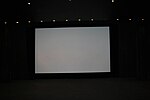Lamination (cinema)
Lamination (sometimes called Kasch for short ) refers to the black edge of the screen in the cinema , which limits the projection surface used. Since films are shown in different formats or aspect ratios (1.33: 1, 1.66: 1, 1.85: 1; up to 2.55: 1 with CinemaScope ), the edge can be moved in cinemas. In most cinemas, the screen is constructed in such a way that it shows a picture in cinemascope format with the maximum picture size and narrower formats are limited by a movable cover. The screen is seldom designed for a picture in widescreen format (today usually 1.85: 1), and the lamination is moved at the top and bottom of the screen. In individual cases, both procedures are combined. The side edge is often moved together with the curtain.
The edge of the lamination is slightly smaller than the illuminated area of the canvas. Since the lining has a sharp edge and does not reflect the incident light significantly, it forms a rectangular, sharp and calm border of the picture.
When playing movies on television or from a video cassette or DVD , the black bar at the top and bottom of the picture is also referred to as a lamination. This is due to the different aspect ratios of the cinema picture and television picture; in addition (or instead of the representation with bars), a part of the "wide" cinema picture is often cut away at the side.

